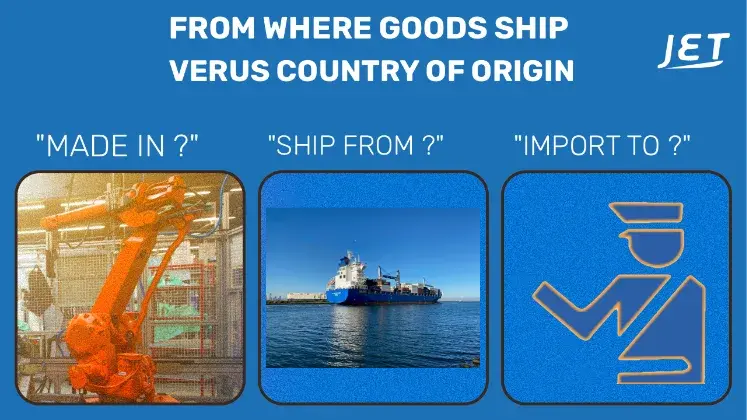
Certificate of Origin and Country of Origin Rules
Quick take: In international shipping, “country of origin” usually means where a product was made—not simply where it ships from. Getting this right affects duty rates, free-trade eligibility, quotas, and compliance checks. This guide explains how origin is determined, when a Certificate/Certification of Origin is required, what data to include, and practical ways to avoid delays and overpaying duties.
Why Country of Origin Matters
- Duty and taxes: Origin drives the tariff rate (MFN vs. preferential), and whether a free-trade agreement (e.g., CUSMA/USMCA/T-MEC, CPTPP, CETA/UKTCA) can reduce duty—often to 0%.
- Regulatory controls: Sanitary/phytosanitary checks, quotas, trade remedies, or sanctions can depend on origin.
- Data and risk: Customs uses origin in analytics and post-entry audits. Errors can trigger reassessments.
Common misconception: The country you ship from is not automatically the origin. Origin is generally determined by where the product was manufactured or last substantially transformed.
Certificate of Origin vs. Certification of Origin
Certificate of Origin (CO/COO): A trade document attesting that goods are originating in a given country. Historically chamber-issued; still used for non-preferential needs and certain destination requirements.
Certification of Origin (self-certification): Most modern FTAs allow a statement on the commercial invoice or a separate document—signed by the exporter, producer, or importer—containing the agreement’s minimum data elements. We use “certificate/certification” interchangeably in this guide.

Non-Preferential vs. Preferential Origin
- Non-preferential origin: Used when no FTA benefit is claimed. Some destinations or letters of credit still require a chamber-stamped CO.
- Preferential origin: Used to claim reduced/zero duty under an FTA. Requires meeting that FTA’s rules of origin and providing a valid certification.
Who Can Issue/Sign Origin Documents?
- Exporter/producer self-certification: Widely allowed under modern FTAs (e.g., CUSMA/USMCA, CPTPP, CETA/UKTCA).
- Importer certification: Permitted by some FTAs (check local rules—e.g., Mexico’s practice may vary by year/version and commodity).
- Chamber-issued COs: Still used for non-preferential needs or buyer/bank requests.
Related Resources
Disclaimer: Jet Worldwide content is for general information only. Always confirm with your consignee, broker, and relevant authorities.
How Rules of Origin Actually Work
Each FTA defines “originating” using tests your product must meet. The most common mechanisms:
- Wholly obtained/produced: e.g., agricultural, mined, or wholly grown in the FTA country.
- Tariff shift (CTC): Non-originating inputs undergo a specified change in tariff classification (e.g., change in heading/subheading) due to processing in the FTA region.
- Regional value content (RVC): A minimum regional % of value must be met (transaction value or net cost method).
- Specific processing: Required manufacturing operations for certain commodities.
- De minimis / tolerance: Limited non-originating content may be disregarded.
- Accumulation: Inputs from FTA partners can count as originating.
Practical Examples
- Drop-ship misconception: If goods are made in Country A and ship from Country B, origin is still Country A unless a qualifying substantial transformation occurs in B.
- Simple assembly: Basic packing or minor assembly typically does not create origin.
- Mixed BOMs: Use supplier declarations to substantiate originating content; keep records for audits.
What to Include on a Certification of Origin
Modern FTAs specify minimum data elements (wording may vary). Generally include:
- Certifier (importer/exporter/producer) and signature/date
- Exporter / Producer / Importer: names, addresses, contact details
- Description of goods and HS code (6+ digits as required)
- Origin criterion (e.g., wholly obtained, tariff shift, RVC)
- Blanket period (if covering multiple shipments)
Sample neutral certification text (adapt to the FTA you’re using)
I certify that the goods described herein qualify as originating under the applicable free-trade agreement rules of origin and that the information contained in this document is true and accurate. I agree to maintain and present supporting records upon request by the customs authorities.
Low-value relief: Some regimes waive formal proof under certain value thresholds (e.g., up to ~CAD $3,300 for many Canadian FTAs). Importers must still retain records and may be asked to provide proof later. Always confirm the current threshold and documentation rules for your route and agreement.
Records to Keep (and Mistakes to Avoid)
- Keep: BOMs, supplier origin declarations, costing, process notes, prior rulings, and copies of certifications/invoices.
- Avoid: Using “ship-from” country as origin, generic product descriptions, expired blanket periods, unsigned/undated statements, and HS codes that don’t align with the origin rule used.
USMCA/CUSMA/T-MEC: Certification of Eligibility vs. Certification of Origin
Certification of Eligibility (TPL): Applies to specific textile/apparel scenarios using Tariff Preference Levels. It confirms compliance with TPL rules to access preferential quotas.
Certification of Origin: Confirms goods meet USMCA rules of origin for preferential duty treatment (applies broadly beyond TPL items). Different purpose from “eligibility.”
Quotas, Statistics and Supplier Declarations
- Quotas: Some categories (e.g., apparel, agriculture) can be subject to import quotas tied to origin.
- Statistics: Governments track origin for trade data and risk profiling.
- Supplier origin statements: Critical for complex BOMs. Simple assembly rarely confers origin—ensure tariff shift or RVC is satisfied where required.
Types of Certificates of Origin (What’s What?)
- Preferential CO/Certification: To claim FTA benefits (CPTPP, CETA/UKTCA, USMCA/T-MEC, etc.).
- Non-preferential CO: Confirms origin without claiming an FTA; often chamber-stamped for buyer/bank or destination requirements.
- Program-specific forms: (e.g., EUR.1, Arab–British CO) when requested by the destination or L/C.
Helpful Links
Note: Destination-specific practices (e.g., Mexico CFDI/Carta Porte, importer-only certification rules, etc.) can change. Confirm current requirements before shipping.
International Shipping Options (and When to Use Them)
- Postal services: Lowest cost for small personal parcels.
- Couriers (FedEx/UPS/DHL and programs via Jet): Fast door-to-door with brokerage support.
- Air freight: Best for time-sensitive pallets (often economical to ~100–200 kg).
- Ocean/Surface: LCL/FCL for larger commercial orders.

Partner with Jet Worldwide
Experts- Logistics -Partner Support for over 40 years
Request a Quote Talk to an Expert




